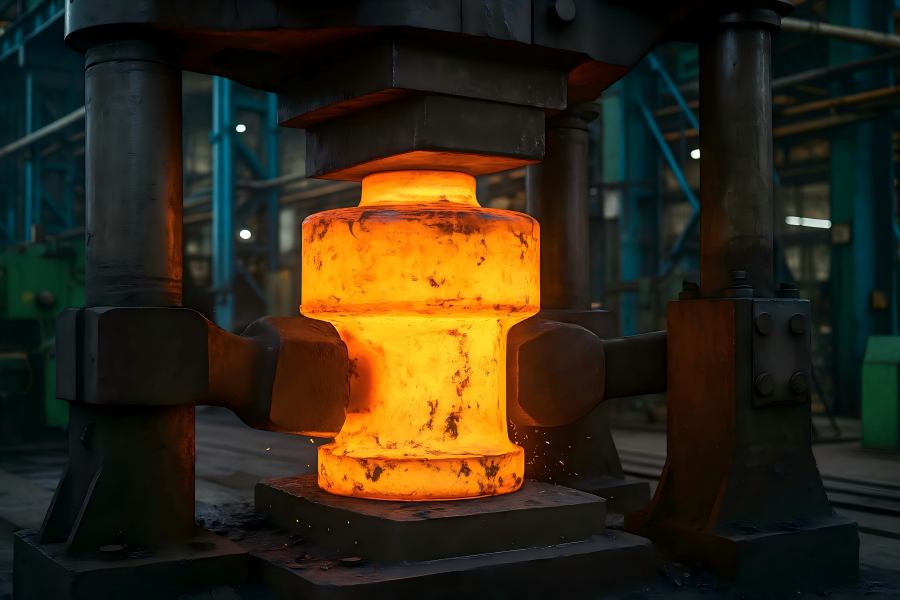In industrial manufacturing, hot forging is one of the most reliable and cost-effective methods for producing strong, durable, and high-performance metal parts. From automotive crankshafts and turbine blades to heavy-duty gears and hydraulic components, forged parts dominate industries where safety, fatigue strength, and dimensional consistency are critical. However, while buyers often focus on per-unit prices, the true cost of hot forging depends on a complex web of technical, operational, and market factors.
Understanding these cost drivers helps industrial buyers make better sourcing decisions, negotiate fair pricing, and balance quality with budget.
The Fundamentals of Hot Forging
Hot forging involves heating metal—typically steel, aluminum, titanium, or nickel alloys—to temperatures above its recrystallization point. This produces finer grain structures and better mechanical qualities by enabling the material to bend plastically under compressive stresses without breaking.
Unlike cold forging, which emphasizes precision and surface finish, hot forging prioritizes formability and strength. The process often uses closed dies (impression dies) or open dies depending on the complexity and volume of the part. Because the metal is malleable at high temperature, the process reduces material waste and enables the production of complex geometries that machining alone could not achieve efficiently.
However, this heat-intensive, tooling-dependent process introduces several cost factors that buyers must understand to evaluate supplier quotations accurately.
Major Cost Components in Hot Forging
Raw Material Cost
Material selection is often the largest single cost contributor, accounting for 40–60% of total forging expenses.
- Material Type: The cost per kilogram of common forging materials like titanium, aluminum, stainless steel, alloy steel, and carbon steel varies significantly. For example, titanium alloys can cost over ten times more than medium-carbon steels due to melting, refining, and machining difficulty.
- Material Size and Shape: Bars, billets, or preforms with larger cross-sections require more heating energy and longer forging cycles.
- Material Utilization Rate: Forging yields (ratio of net to gross weight) influence scrap losses. For high-volume automotive parts, optimizing billet sizing to minimize flash or trimming scrap can significantly reduce total costs.
A buyer should always request details on material grade, billet dimensions, and yield rates in supplier quotes to uncover hidden cost inefficiencies.
Die and Tooling Design Cost
Tooling is the “upfront investment” in any forging program. For closed-die forging, the die must be precision-machined to replicate the final geometry.
- Tool Complexity: Parts with intricate shapes, multiple cavities, or tight tolerances increase CNC machining time for the dies.
- Die Material: Dies for high-temperature alloys must be made from premium hot-work tool steels like H13 or H21, which resist thermal fatigue and wear but are costly.
- Tool Life: Die wear rates depend on part size, temperature cycles, and lubrication. High-volume production amortizes tooling costs more efficiently over time.
Buyers should evaluate whether the supplier offers multi-cavity dies, insert-based tooling (replaceable wear zones), or digital simulation to optimize die life and cost.
Heating and Energy Consumption
Energy costs in hot forging are driven primarily by heating furnaces, presses, and auxiliary systems.
- Heating Method: Induction furnaces heat billets rapidly and uniformly, reducing scale loss, but their equipment cost and energy consumption can be higher than gas furnaces.
- Temperature Control: Overheating increases oxidation and scaling losses (up to 2–5% of material weight). Precise temperature management improves surface quality and reduces waste.
- Equipment Efficiency: Modern presses with regenerative hydraulic systems or servo drives consume less energy than older mechanical models.
Energy costs fluctuate with global oil, gas, and electricity prices, making it essential for buyers to inquire about a supplier’s energy efficiency measures.
Labor and Automation
Forging remains labor-intensive in setup, handling, and inspection, though automation is rapidly changing this.
- Labor Rates: Wages differ dramatically between regions — forging in China or India often costs less per labor hour than in Europe or the United States.
- Skill Level: Skilled operators are essential for maintaining die alignment, temperature control, and press timing. Labor shortages can impact delivery and consistency.
- Automation Level: Automated billet feeders, robotic manipulators, and integrated die-lubrication systems enhance throughput and reduce manual error, but require capital investment.
Buyers should weigh whether a supplier’s labor savings through automation translate into consistent quality and lower per-unit costs.
Press and Equipment Depreciation
Forging presses—mechanical, hydraulic, or screw types—represent millions in capital investment. Equipment amortization directly affects the cost structure.
- Press Capacity: Larger tonnage presses (1,000–5,000 tons) incur higher depreciation and maintenance costs per hour.
- Utilization Rate: A highly utilized press spreads fixed costs across more parts.
- Maintenance Schedule: Regular maintenance prevents downtime but increases indirect costs.
When comparing suppliers, buyers should assess equipment age, capacity range, and whether the press tonnage is optimized for their part size.
Process Complexity and Volume
Production scale strongly affects cost per part.
- Low-Volume or Prototype Runs: Require dedicated setup and tooling costs spread over fewer parts, increasing unit price.
- High-Volume Production: Benefits from economies of scale, automated handling, and reduced setup amortization.
- Multi-Stage Forging: Large or complex parts often require preforming and final forging stages, adding extra heating and labor steps.
Buyers should clarify expected annual volumes early to negotiate scalable pricing models.
Post-Forging Operations
Forged parts rarely leave the press ready for assembly. Post-processing adds both quality and cost.
- Trimming and Flash Removal: Removing excess metal ensures dimensional accuracy but adds machine time.
Heat Treatment: Processes like quenching and tempering restore material hardness lost during forging. - Machining: Final tolerance machining or surface finishing ensures fit and function but can add 20–40% to total cost.
- Inspection and Testing: Non-destructive testing (NDT), hardness checks, and dimensional inspections ensure compliance with specifications.
Advanced suppliers integrate in-house machining and heat treatment, offering better control and shorter lead times.

Secondary Factors Affecting Total Cost
Material Market Fluctuations
Global metal prices — especially for steel, aluminum, and nickel — fluctuate with supply chain conditions, energy costs, and geopolitical factors. Buyers should include price adjustment clauses in long-term contracts or adopt hedging strategies for high-value alloys.
Scrap Management and Recycling
Scrap from trimming, machining, and scaling can be reclaimed and sold, but the efficiency of recycling affects profitability. Suppliers that integrate closed-loop recycling or return scrap to steel mills may offset some raw material costs.
Quality Standards and Certification Costs
Compliance with ISO 9001, IATF 16949, AS9100, or API Q1 standards adds auditing, documentation, and testing expenses. Aerospace and defense parts often require full traceability and destructive testing, raising cost per part but ensuring reliability.
Logistics and Location
Transportation of heavy forged components can significantly affect landed cost. Buyers should consider proximity to suppliers, access to ports or highways, and local logistics infrastructure. Packaging for corrosion protection and safe handling adds further cost.
Environmental Regulations and Sustainability
Stricter emissions, energy efficiency, and waste management laws can increase production costs, especially in Europe and North America. Conversely, suppliers using clean energy sources or energy-recovery furnaces may offer lower long-term environmental fees and better ESG performance.
How Forging Design Impacts Cost
Buyers often overlook that product design itself is a cost determinant. Collaborative engineering between buyer and supplier can unlock significant savings.
Shape Simplification
Reducing unnecessary ribs, pockets, or thin walls simplifies die manufacturing and lowers defect rates. A well-optimized shape can reduce die wear and forging steps.
Draft Angles and Fillets
Appropriate draft angles allow easier ejection from dies, while generous fillets prevent stress concentration and die cracking. This directly translates into longer die life and less rework.
Material-to-Shape Matching
Selecting a forging alloy whose flow characteristics match the shape ensures proper fill and avoids underfills or laps. Poor match increases scrap rates and rework.
Tolerance Optimization
Buyers sometimes specify tighter tolerances than necessary. Relaxing tolerances within functional limits allows the use of rougher dies or fewer machining passes, reducing both tooling and cycle time costs.
Cost Comparison: Hot Forging vs. Other Manufacturing Methods
Buyers often compare hot forging with casting, machining, or additive manufacturing. Each process has different cost-performance trade-offs:
| Process | Typical Cost Drivers | Advantages | Limitations |
| Hot Forging | Material, die, heating, machining | High strength, fatigue resistance, refined grain | High tooling cost, limited fine detail |
| Casting | Mold, melting, cooling | Design flexibility, near-net shape | Porosity, lower mechanical strength |
| Machining | Raw stock, tool wear, cycle time | Precision, surface finish | High material waste |
| Powder Metallurgy/Additive | Powder cost, sintering | Complex shapes, minimal waste | High raw material cost, limited size |
In most load-bearing applications, forging remains the most cost-effective long-term solution when factoring in lifecycle performance, maintenance, and safety.
Supplier Cost Structures and Transparency
A common frustration among industrial buyers is the lack of transparency in forging quotations. Suppliers may provide a single price without explaining cost allocation. Understanding the structure allows better negotiation.
A typical cost breakdown might look like:
- Raw Material: 45%
- Labor & Energy: 20%
- Tooling Amortization: 10%
- Overheads (maintenance, quality): 15%
- Profit Margin: 10%
Buyers should request itemized quotes, especially for new tooling projects, to understand fixed versus variable costs.
Suppliers that adopt lean manufacturing and digital forging simulations (using DEFORM or QForm software) can optimize flow lines, reduce material waste, and pass savings to the buyer.
Cost Reduction Strategies for Buyers
Early Supplier Involvement (ESI)
Engaging forging engineers during the design stage ensures manufacturability. Suppliers can recommend alloy alternatives, adjust fillets, or consolidate parts to reduce material and tooling costs.
Volume Consolidation
Combining similar parts or standardizing materials across product lines can leverage economies of scale and simplify inventory management.
Long-Term Agreements (LTAs)
Multi-year contracts with agreed escalation clauses can stabilize pricing and secure production priority, especially during material shortages.
Benchmarking and Dual Sourcing
Comparing global suppliers or maintaining two approved sources ensures competitive pricing and supply security.
In-House vs. Outsourced Machining
In some cases, buyers can perform final machining in-house if they have existing capacity, avoiding markups from the forging supplier.
Regional Cost Differences and Global Sourcing
Forging cost structures vary worldwide:
- Asia (China, India, Vietnam): Lower labor costs, improving quality standards, strong export orientation. Suitable for medium to large volumes with moderate tolerance requirements.
- Europe (Germany, Italy, Poland): High energy and labor costs but world-class tooling and quality systems. Ideal for safety-critical parts like aerospace or automotive.
- North America: Balanced between cost and compliance; strong domestic supply chains but sensitive to labor and environmental costs.
When importing, buyers must factor in tariffs, shipping costs, lead times, and potential quality risks. A landed cost analysis often reveals that domestic or regional suppliers are more cost-effective for high-value precision parts.
Case Example: Forged Gear Blank for Heavy Machinery
Consider a buyer ordering 10,000 steel gear blanks weighing 8 kg each.
- Material (42CrMo4): $2.80/kg × 8 kg = $22.40
- Yield (90%): Effective material cost = $24.89
- Energy & Labor: $4.50 per piece
- Tooling Amortization: $1.50 per piece
- Machining & Heat Treatment: $6.00 per piece
- Overheads & Profit: $3.00 per piece
→ Total Cost: ≈ $39.89 per part
If production volume increased to 50,000 units, tooling amortization would drop fivefold, reducing total cost by nearly 4% per unit. Likewise, if the material yield improved to 95%, savings of $1.50–$2.00 per unit would accrue. Such scenarios underscore the compounding effect of efficiency improvements on overall cost.
Evaluating Supplier Quotations: Checklist for Buyers
Before finalizing a forging order, industrial buyers should assess:
- Material and yield details (grade, billet size, scrap percentage)
- Tooling and die life (replacement cycle, maintenance policy)
- Production process (open die, closed die, press type)
- Energy and heating efficiency (furnace type, temperature control)
- Post-processing services (heat treatment, machining, inspection)
- Quality certifications (ISO, AS, IATF, API)
- Lead time and delivery reliability
- Geographical logistics and import duties
- Sustainability and emissions compliance
- Pricing transparency and revision terms
A supplier who can provide clear data for each of these points demonstrates maturity, consistency, and cost awareness.
